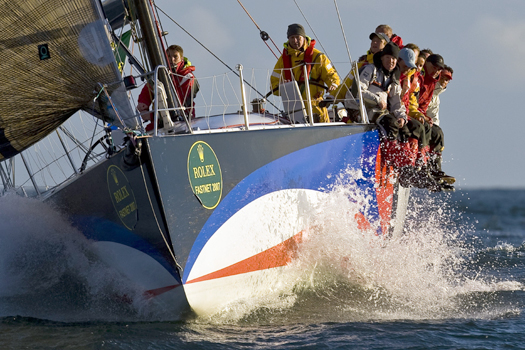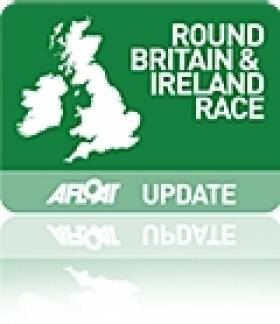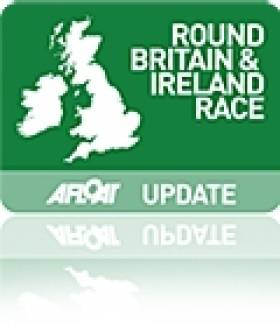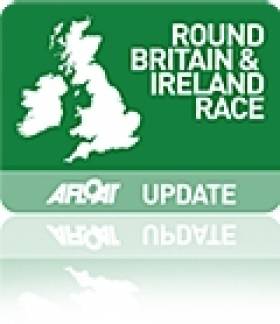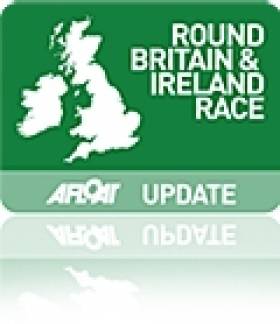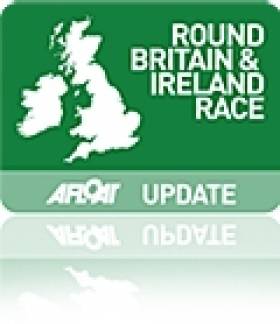Displaying items by tag: Round Britain & Ireland Race
#srbi – The National Yacht Club and ISORA have announced that Liam Coyne, Co-Skipper of "Lula Belle" will give a talk in the National Yacht Club, Dun Laoghaire on the 12th November at 20.30. All are welcome to attend this unique presentation.
The "Dynamic Duo" of Liam Coyne and Brian Flahive came together for only one race in the season of 2014. They had sailed two-handed together for many years taking an active part in ISORA and also competing in the D2D, Round Ireland and the Fastnet races.
The full story of their campaign featured in WM Nixon's weekly sailing blog on Afloat HERE.
At the end of last season Brian had moved to live in Malta so it was decided that if they were to sail together again they would have to make it "worthwhile". To make it worth the trip from Malta they decided to enter the 1800 mile Sevenstar Round Britain and Ireland Race!!! As the organisers had only just allowed two-handed entries for the first time, they seized the moment and entered.
They could not have picked a worst year to take part in this race. The weather conditions for the start were affected by the remnants of Hurricane Bertha. So bad was the weather that the organisers changed the direction of the race to go anti-clockwise around the course. To avoid the worst of the weather the start was also delayed for 18 hours. 28 boats took part in the race.
Racing Two-Handed around Britain and Ireland requires all round skill, great seamanship and tenacity. Most of the time the Two-Handed pair are alone on deck while the other sleeps. It can be a lonely existence on deck and the lack of sleep and the effects of exposure to the harshest of conditions is bound to take its toll on both yacht and crew.
Lula Belle overcame all the challenges that the course could throw at them. Despite significant breakages and technical problems, they limped over the finish line at 11:40:54 on Saturday 23rd August in an elapsed time of 12 days 02 hours 40 minutes and 54 seconds. They took 5th place overall in the race and 1st in the Two-Handed Class and the combined IRC Three and IRC Four Class.
Liam Coyne will give a talk on his adventure. He will talk about the technical and mental preparation required before and during the race. With the inclusion of video excerpts he will describe the challenges both he and Brian faced and how they dealt with them.
This talk is a great opportunity for any sailor who ever dreamt of racing offshore to learn about the severe challenges Liam and Brian lived through while taking part in what is probably the most challenging offshore race ever.
Liam will give his talk in the National Yacht Club, Dun Laoghaire on the 12th November at 20.30. All are welcome to attend this unique presentation.
Bar food is available in the Club before the talk.
For any enquiries contact Peter Ryan – 087 2545037 or [email protected]
Go LulaBelle! How Ireland Won The Round Britain & Ireland Race
#rorcsrbi – For twelve days, Ireland's sailing and maritime community followed with bated breath while the fortunes of Liam Coyne and Brian Flahive with the First 36.7 Lula Belle waxed and waned in the storm-tossed 1802-mile RORC Sevenstar Round Britain & Ireland Race. Last Saturday, they triumphed, winning the two-handed division and two RORC classes in this exceptionally gruelling marathon. W M Nixon delves into the human story behind the headlines of success.
It used to be said that Irish seamanship was the skilled and stylish extrication of the vessel from an adverse and potentially disastrous situation in which she and her crew shouldn't have been next nor near in the first place.
While we may have moved on a bit from that state of affairs with a less devil-may-care approach to seafaring, there's no escaping the fact that this morning we can now look back at two remarkable Irish victories in topline international offshore events in recent years in which both crews overcame major setbacks and situations, rising above very adverse circumstances which could well have deterred sailors from other cultures where the philosophy is not underpinned by the attitude: "Ah sure lads, things aren't good. Not good at all. But let's just give it a lash and see how we go".
It was seven years ago when a full entry list of 300-plus boats was slugging westward down the English Channel in the first stages of the Rolex Fastnet Race 2007. Already, the start had been postponed 24 hours to allow one severe gale to go through. But in an event still dominated by the spectre of the 15 fatalities in the storm-battered 1979 race, most crews were hyper-nervous about another gale prospect, and by the time the bulk of the fleet was in the western English Channel, many succumbed to the allure of handy ports to lee such as Plymouth, and in those early days of the race something like 48% of the fleet retired.
But aboard Ger O'Rourke's Cookson 50 Chieftain out of Kilrush on the Shannon Estuary, they were well into their stride. That year, the boat had already completed the New York to Hamburg Transatlantic Race, placing second overall. But owing to her Limerick owner's quirk of never confirming the boat's entry for the next major event until the current one is finished, they found themelves only on the waiting list for that year's already well-filled Fastnet Race entry quota.
Chieftain was 46th on that list. Yet while those who had made an early entry fell by the wayside, steadily this last-minute Irish star rose up the rankings. With three days to go, Chieftain got the nod. They went at the racing after the delayed start as though this had been a specific campaign planned and carefully executed over many months with a full crew panel, instead of a last-minute rush where crew numbers were made up by a couple of pier-head jumpers who proved worth their weight in gold.
Yet then, as the new strong winds descended on the fleet as the group in which Chieftain was already doing mighty well was approaching the Lizard Point, the troubles started, with gear failing and boats pulling out left and right. But the Irish boat was only getting into her stride. A canting-keeler, she could be set up to power to windward in a style unmatched by bigger craft around her. Approaching the point itself in poor visibility to shape up for the fast passage out to the Fastnet Rock with even faster sailing, things looked good. And then the entire electronics system aboard went down, and stayed down.
Here they were, not even a third of the way into a race which promised to be rough and tough the whole way, but a race in which they would at least have been expecting know their speed, performance and position down to the most minute detail. Instead, they were in an instant reduced to relying on a couple of tiny very basic hand-held GPS sets, and paper charts.
Ger O'Rourke's Chieftain sweeps in to the finish at Plymouth to win the 2007 Rolex Fastnet Race overall
Those paper charts were little better than pulp by the end of a very wet race in an inevitably extremely wet but searingly fast boat. But they did get to the end, and with style too. They won overall and by a handsome margin. It was the first-ever Irish total victory in the Grand National of Ocean Racing. The owner-skipper had to go up the town to buy himself a clean shirt for the prize-giving in the Plymouth Guildhall.
Yet when Ger O'Rourke's Chieftain swept into Plymouth and that triumph just over seven years ago, the boat was in much better racing shape than Liam Coyne's First 36.7 Lula Belle when he and Brian Flahive completed the final few miles back into Cowes around midday last Saturday to finish the 1802-mile Sevenstar Round Britain & Ireland Race.
Lula Belle had many gear and equipment problems after an extreme event where the natural pre-start nervousness had been heightened by a reversal by the Race Management of the originally clockwise course as the 10th August start day approached. It would have been folly to send the fleet westward into storm force westerlies in restricted waters. Eastward was the only sensible way to go.
Then the arrival of the remains of Hurricane Bertha – which seemed to be finding new vigour – led to new tensions with the start being postponed from midday Sunday to 0900 Monday. It was disastrous from a general publicity point of view. But it would have been irresponsible to send a fleet of boats – some of them mega-fast big multihulls – hurtling towards the ship-crowded narrows of the Dover Straits beyond the limits of control in a Force 11-plus from astern.
Even when they did race away, it was with a Force 8 plus from the west, with the Irish crew recording 42.5 knots of wind aboard Lula Belle (and from astern at that), before they lost all their instruments from the masthead on the first night out. For a double-handed crew, that was a very major blow. Two-handers are allowed to use their auto-pilot, and if all the wind indicators are functioning in proper co-ordination with it, then the boat can sail herself along a specific setting on the wind. It's as good having at least one extra hand – and a skilled and tireless helmsman at that - on board.
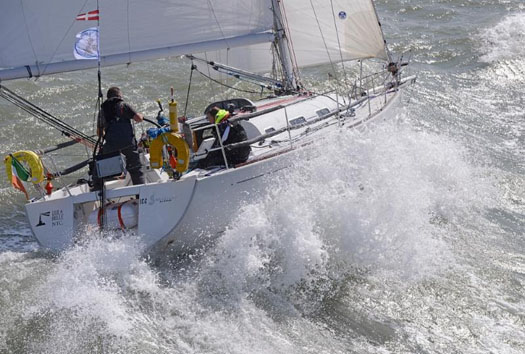
Lula Belle on her way out of the Solent with 1800 miles to race and everything still intact. Photo: Rick Tomlinson
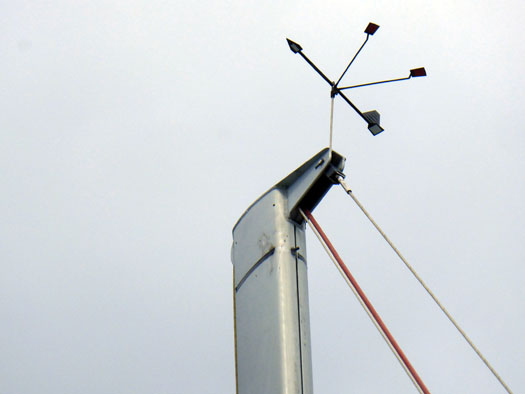
There it was – gone. After the first night at sea, Lula Belle's masthead was bereft of everything except an often defective Windex. Photo: W M Nixon
Fortunately the auto-pilot itself was still working on its own, and they became well experienced in setting the boat on course and then trimming the sails to it in a continuous process which worked well except when the seas were so rough and irregular that they had to hand steer in any case, albeit with the apparent wind indicated only by the sole survivor of the masthead units, the little standard Windex. But it must have been damaged when everything else was swept away, as from time to time it jammed. When that happened, the only wind indicators available to the two men were the Sevenstars battleflag on the backstay, the tell-tales on the sails, or a moistened finger held aloft, as neither were smokers.
Despite this, they made their way north through the North Sea and all round Scotland and its outlying islands and right down the western seaboard of Ireland as far as the Blaskets before things went even more pear-shaped. In fact, the wheels came off.
Their ship's batteries had been showing increasing reluctance to hold power, essential for the continuing use of the autohelm and the most basic need for lighting and any still-usable electronic equipment including the chart plotter. But thanks to a trusty engine battery, they could start the motor to bring the ship's batteries back up to short-lived strength. Yet while approaching the Blaskets, the engine refused to start, and nothing they could do would coax it back to life. Inevitably they lost power, and for the final 495 miles of the race – the equivalent of 78% of a Fastnet Race - the boat was sailed and navigated entirely manually, with the required navigation lights provided by modified helmet lamps.

The chart plotter shows only too clearly where power was lost completely just north of the Blaskets. Photo: W M Nixon
Yet they finished well last Saturday, around noon on August 23rd after twelve days racing. They won the two-handed division overall, they won Classes IV & V, and they placed sixth overall in a combined fleet in which big boats with a strong element of professional crewing dominated. So who are Liam Coyne and Brian Flahive, and what about Lula Belle, the heroine of the tale?
Afloat.ie caught up with them on Thursday morning in Dun Laoghaire marina, where they'd got home an hour or so before dawn to grab a quick sleep of a few precious hours before awakening to more sunshine than they'd experienced for a long time, as the Round Britain & Ireland was raced across an astonishingly sunless sea. As for the 450-mile passage home to Dublin Bay, it had been achieved through mostly miserable weather and an enforced and brief stop in Plymouth to try to get a final solution to the continuing electric problems, which had defeated the finest minds in Cowes.
But such hassle fades when the return home is completed, and the Lula Belle crew were in great form. They complement each other. Brian Flahive is from Wicklow and he's a studious, thoughtful type. He turned 31 just three days after the win, making it his best birthday ever, and a fitting highlight in a sailing CV which continues to develop, and began with local sailing and training courses with Wicklow Sailing Club after his sister Carol had acquired a Mirror dinghy.
Since then, Carol's seagoing has taken a slightly unexpected turn as she found her vocation in the lifeboat service, and that is now her main interest afloat - she is a helm on the Wicklow lifeboat. But her younger brother Brian was soon hooked on pure sailing, and from the Mirror he soon went on the 420s where his enthusiasm was noted by local keelboat owners, who in turn recruited him aboard, and soon he was noted by those assembling offshore racing crews too.
When you've talent, enthusiasm and time available, the word soon gets about in the limited recruiting pool available to Ireland's offshore racing folk. Soon, young Flahive was spreading his wings with his home port's biennial Round Ireland race, and participation in Irish Sea Offshore Racing. He proved adept at and interested in two-handed sailing in particular, and soon got to know another relative newcomer to the Irish Sea offshore racing scene, Liam Coyne.
Liam Coyne is 47, and something of a force of nature. There's a mischievous twinkle to his eye, but there's a very serious side to him too, even if – as when he admits he's extremely competitive – it's done in the best of humour. He's from Swinford in County Mayo, where any knowledge of boating might relate to the big lake of Lough Conn nearby. But as he left Mayo for the USA just as he was turning 20, his passionate sailing involvement has been entirely generated during his more recent life in Dublin.
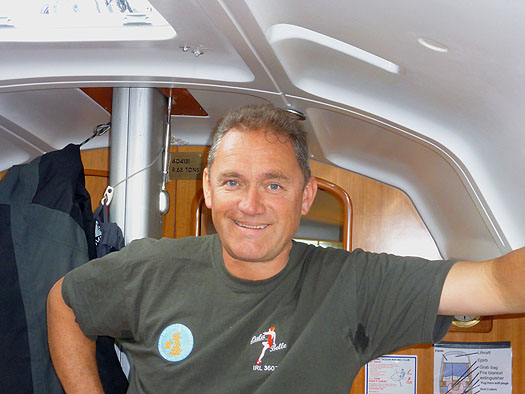
There's a mischievous twinkle, but Liam Coyne makes no secret of his competitive nature. Photo: W M Nixon
Back in the 1980s, well before Australia took off as the destination of choice for energetic and ambitious young Irish people, America was still the Land of Dreams. Coyne's teacher of English in Mayo was so sure of this that one of his courses was built entirely around the USA's immigration examination. He did a good job, young Coyne made the break, and he started to fulfill his ambition of getting to all the American states by spending time – sometimes quite a lot of it – in 26 of the States of the Union. Eventually with a winter approaching, he found the building site he was quietly working on in Boston was due to close completely for the colder months. But he managed to swing a job selling Firestone tyres (sorry, "tires") from the local agent's shops. It was a union created in heaven. Liam Coyne and tyres – the bigger the better – were made for each other.
He prospered in the tyre business in Boston and enjoyed his work, but there was always the call of home and a girl from Swinford who had qualified as a teacher. So he came back to Ireland in 1998, set up in the tyre business in Leinster, married the girl and settled down in south Dublin to raise a family.
Came the boom years, and the tyre business prospered mightily. Liam Coyne Tyres had five depots and employed 48 people. He was mighty busy, but seeking relaxation. So on the October Bank Holiday Monday in 2005, he and his wife went to the Used Boat Show at Malahide Marina and by the time they left, Alan Corr of BJ Marine had sold them a handy little Beneteau First 211, their first boat.
His knowledge of boats and sailing was rudimentary to non-existent. His maiden voyage, the short hop of 12 miles from Malahide to his recently-joined new base at Poolbeg Y& BC in Dublin port, took all of 14 hours as the tyro skipper battled with the peculiarities of tide and headwinds, happily ignoring the potential of the little outboard engine on the transom even though, as Alan Corr cheerfully told him later, it could have pushed the boat all the way to Arklow in half the time.
But he was enchanted by this strange new world, and the camaraderie of the sailing community as expressed in Poolbeg. He made a tentative foray into the club's Wednesday night racing, and was even more strongly hooked. But even though those Wednesday club races in the inner reaches of Dublin Bay were such fun that from time to time he still returns to race with his old clubmates at Poolbeg, he knew that his ambitions would dictate a move into a larger boat, and the bigger world of Dublin Bay sailing. So when the next Dublin Boat Show came along, he went to it and ended up buying a Bavaria 30 from Paddy Boyd, who was marketing Bavarias in the interval between being Secretary General of the Irish Sailing Association, and Executive Director of Sail Canada.
Paddy Boyd wised him up to the Dun Laoghaire sailing scene, and which club he might find the most congenial while being suited to his ambitions. For Liam Coyne was discovering offshore racing, and particularly the annual programme of the Irish Sea Offshore Racing Association. He liked everything about ISORA, the friendships, the willingness to help and encourage newcomers, and the pleasant sense of a mildly international flavour between the English, Welsh and Irish contingents.
One of his fondest memories is of taking his Bavaria 30 across to North Wales for the annual Pwllheli-Howth race which traditionally rounds out the season, and is often blessed with Indian summer weather. As he headed away from Dublin Bay, he suddenly realised it was the first time he had ever left Ireland under his own command. All previous exits had been on scheduled ships or planes. It was a very special moment.
Yet while he treasures the memory of such special moments, it wouldn't be Liam Coyne if he wasn't moving on. He'd relocated his base of operations to the bigger scene of the National Yacht Club and Dun Laoghaire, and developed his taste for double-handed offshore racing and its link to a group whose only common denominator seemed to be that many of them shared an enthusiasm for racing vintage Fireballs in Dun Laoghaire harbour in the winter.
But in the summer, keelboat offshore racing with just two on board was increasingly their main line, and he was soon on terms of friendship with the likes of Brian Flahive, Barry Hurley and others, while the double-handed class in events like the Dun Laoghaire-Dingle, the Round Ireland, and the Fastnet itself were coming up on the radar.

The newly-acquired First 36.7 which became Lula Belle greatly broadened the scope of Liam Coyne's offshore racing. Photo: W M Nixon
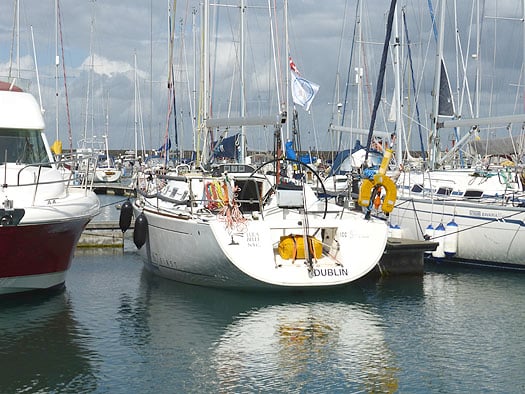
The First 36.7 is of a useful size to be a very pleasant family cruiser, but Lula Belle has been a multi-purpose boat since Liam Coyne bought her, with the emphasis on double-handed offshore racing, and the longer the course, the better. Photo: W M Nixon
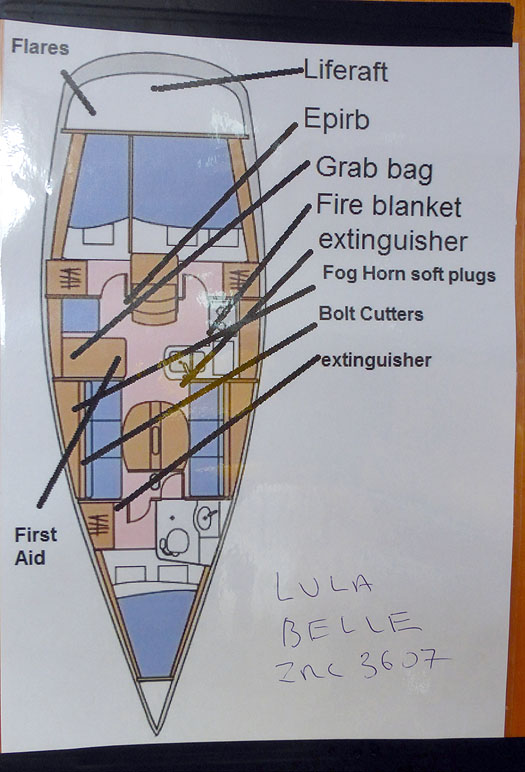
Lula Belle's layout - the accommodation of a cruiser/racer with extras installed for serious offshore racing, but for proper cruising they'd also be required. Photo: W M Nixon
Having made his mark offshore partnered with Brian Flahive on the Bavaria, he very quickly moved up to the almost-new First 36.7 Baily, bought from Tom Fitzpatrick of Howth. His name of Lula Belle for the boat was inspired by a recently-deceased aunt who had invariably addressed all of his sisters as "Lula Belle" when requesting something like a cup of tea. It's certainly a distinctive name, and it was beginning to feature regularly in short-handed and fully-crewed offshore racing reports when Ireland fell off the economic cliff around 2007.
The tyre business was hit particularly hard, for they're items whose replacement people can try to avoid by shifting used tyres around on and between vehicles to get the last piece of tread usable. But fortunately, one of his key contracts was in the heavy industrial area, where they use tyres so big your everyday motorist has no notion of them, yet legal safety working requirements dictate their regular replacement.
Despite this, at one stage his fine workforce of 48 had become effectively just two, while three of the five depots were closed. "I can tell you" he says, "there were times when we were glad enough the wife had kept her teaching job". And they were raising a family, eventually with three kids with a much-loved holiday home at Enniscrone in southwest Sligo. Then too he had this 36ft racing boat too. Yet all his fine assets and the value of the family home in Dublin had effectively been slashed by at least 50% and often more.
But somehow he kept going, and he even continued to race offshore. By this time one of the leading figures in the Irish short-handed sailing scene, Barry Hurley, had moved to Malta, and when he was recruiting crew for a friend with a Grand Soleil 40 for the annual 620-miles Middle Sea Race from Valetta in late October, he filled four berths with able-bodied crew from Dublin including Barry Flahive and Liam Coyne.
That race brought something of another epiphany to match that moment of pure joy at realizing he was skippering his own boat out of Irish waters for the first time. They'd come through the Straits of Messina eastward of Sicily, and next turn of the course was the volcanic island of Stromboli. It was a blissfully warm summer's night, and Liam was at the helm in just shorts and shirt, enjoying the sail and revelling in the race.
Stormboli was gently erupting just enough to show it was there, and ideal to be a mark of the course. "I'll tell you," says Liam, "it was a very long way indeed from your usual October night in Swinford". The magic of the moment reinforced his ambition to see his business through the recession and out the other side, which he has now achieved with busy depots in Navan and Dublin, and staff back above the twenty mark. Yet oddly enough, it also reinforced a shared ambition with Brian Flahive to do the four-yearly Seven Stars Round Britain & Ireland Race, when conditions up in the northern seas off Shetland and across towards the Faroes can often make an October night in Swinford seem like the balmy Mediterranean by comparison.
But the idea just wouldn't go away, and they put down their names for the 2014 race. With the economy coming out of intensive care and two good managers running his two depots and the three kids though the very young stage, Liam Coyne felt he could take off the time for this major challenge. But even so it was done without any form of shore management support, and in fact he managed to mix it with some family cruising – to which the boat is surprisingly well suited – by taking his young son Billy (10) and daughter Katie (8) along with him for a leisurely delivery to Cowes by way of many of the choice and picturesque ports along the south coast of England, where his wife and the youngest child joined the party to see them off.
That was in the last of the summer. By the time the starting date was upon them, it was as if a giant and malevolent switch had been activated. The weather was horrible, and even when Bertha had finally grumbled along on her way, it was anticipated that the rush of bitterly cold north winds she'd drag down from the Arctic in her wake would be every bit as unpleasant.
Then came the complete reversal of the course, and the postponement of the start. For a crew who were being their own shore managers and technical support team, it added a last minute mountain of research work on the shape the weather might be when they finally got away, and all the mental strains of waiting overnight for the start. As the lowest-rated boat in the entire fleet, they may have had the consolation of knowing that if they finished with just one boat behind them then they wouldn't be last on corrected time. But by being the low-rater, they would probably finish so long after everyone else that any general celebration would be long over.
That said, when a double-handed team have already successfully bonded, they're better at withstanding the strain of an enforced wait for a delayed start than a larger crew. I can remember only too well when the RORC Cowes to Cork race of 1974 was postponed for ten hours by the then RORC Secretary Mary Pera. A Force 10 sou'wester was making the Needles Channel a complete maelstrom on the spring ebb, but it was forecast soon to ease, so we were to be sent off on the evening ebb.
To get through the wait, it seemed best to stay well away from the boat and have a quiet day if at all possible. But aboard the 47-footer on which I was sailing, there were action men who decided it was time for a party lunch. So although I slunk away alone up the back streets of Cowes (Kensington-on-Sea it was not), and found a little café where the owners were persuaded to provide lunch of boiled potatoes and steamed fish instead of the usual nausea-inducing fish'n'chips, back on the waterfront others meanwhile had different ideas. A massive former rugby international in our crew decided the best way to pass the time was a champagne reception in one of the Cowes clubs followed by a bibulous lunch, and he persuaded several shipmates to join him, though they were circumspect in their consumption while he went at it as though it would be the last festive lunch in his life.
When we finally got racing the wind had indeed eased, though things were still rough enough in the Needles Channel, where we slammed into a head sea with such vigour that the Brookes & Gatehouse speedo impellor – normally a particularly stiff-to-move bit of equipment – was shot into its hull housing so totally we assumed it had broken entirely. It took a few seconds to realize what had happened, and it worked again happily enough once it had been pushed back into working position with the usual robust heave.
However, our mighty rugby forward was not so happy. He was not a happy budgie at all. The news is that, though you may be battering along noisily but successfully with endless bangs and squeaks and groans of one sort or another, when an international rugby forward of classic size gets massively seasick, a new dimension enters the sound and vibration scene - it's as if the entire boat is shuddering from end to end.
But enough of that. In Cowes on the morning of Monday August 11th 2014, it was still blowing old boots from the west , but they tore away downwind like there was no tomorrow. And for some, as far as racing was concerned, there wasn't. Any tomorrow, that is. There were several overnight retrials that set out to be temporary but became permanent. Aboard Lula Belle, however, they were still going strong, but after recording that gust from astern of 42.5 knots (which meant it was pushing 50), the masthead broccoli decided it had had enough, and made its exit.
Some time long before the race, Liam had decided he'd ensure the minimum use of power by having a LED tricolour masthead light, and a technician had been sent aloft to fit it. But that first night, it took off on its own, but taking much else with it, and leaving a beautifully clean masthead, but damn all information for those down below other than a Windex with an increasing tendency to jam.
And already the sails were suffering, for although their gybes were hectic enough, they didn't have to worry about check-stays or runners. But the downside of that was the well-raked spreaders, which helped support the mast in the absence of any aft support rigging other than the standing backstay. The inevitably prominent upper spreader-ends were chafing holes in the mainsail which, despite repairs, were enormous by the finish.
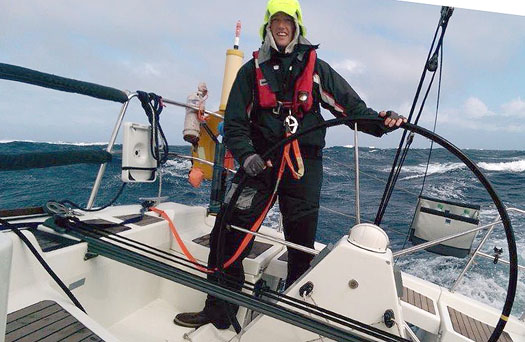
Speed at sea – Brian Flahive on the wheel as Lula Belle puts in the kind of sailing which knocked off 200 miles a day. Photo: Liam Coyne
But they blasted on, roaring on a reach up through the North Sea with Lula Belle doing mighty well, as the more extreme boats such as their closest rival, the Figaro II Rare, weren't quite getting the conditions to enable them to fly, whereas old Lula Belle was knocking off 200 miles in every 24 and saving her time very nicely.
North of the English/Scottish border, the strong winds drew ahead. The forecast, however, was for westerlies, so some boats in front laid markedly to the westward looking for them. But Coyne and Flahive sailed a canny race. What they knew of the weather maps suggested very slow-moving and messy weather systems with lots of wind. And from ahead. They reckoned the prospect of westerlies was just too good to be true. And they were right. On the entire leg up to Muckle Flugga, the most northerly turn, they never strayed more than five or six miles from the rhumb line, and thus they sailed the absolute minimum distance, albeit in very anti-social conditions, to get to the big turn.
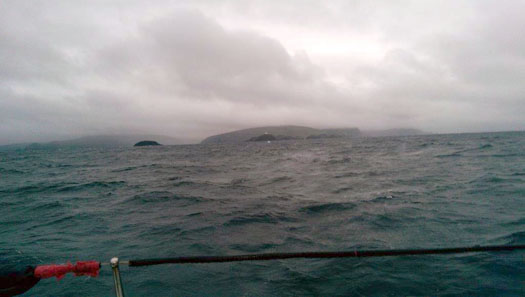
The sunless sea, with Lula Belle getting past Muckle Flugga on Shetland, the northerly turning point of the RB & I Race, and the sky promising plenty of wind Photo: Liam Coyne
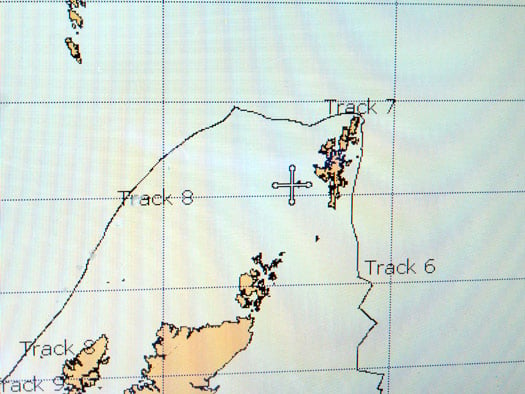
The win move. Although Lula Belle had taken a conservative route northward, once they'd rounded Muckle Flugga they took a flyer to try to get on the favoured side of a slow-moving yet very intense low. The plan succeeded, but they'd to go almost halfway to the Faroes for it to work. Photo: W M Nixon
By this time the faster boats had got back into a substantial lead, but here the situation suited the Irish duo. Those in front went battering and tacking into a fierce sou'wester, trying to get nearer the next turn at St Kilda. But the Irish boat's cunning scheme was to slug directly westward once they'd rounded Muckle Flugga, and not tack until they'd some real prospect of being in the harsh northerlies which they knew to be somewhere out beyond the very slow-moving low pressure area.
Thus they ended up midway between the Shetlands and Orkney to the southeast, and the Faroes to the northwest. As Liam Coyne drily puts it: "When you take a flyer like this and it works, it isn't a flyer any more – on the contrary, it's the only way". What they didn't know was that the boats trying to batter their way past the Outer Hebrides and down towards St Kilda had taken such a pasting that their immediate rival Rare had made a pit stop to rest up in the Shetlands, and others dropped out "for a while" only to find it had become a matter of retiring from the race.
But Lula Belle, having cast the dice to go west, had no option but to keep going, as she was nearly 50 miles west of the Rhumb Line, and more a day's fast sailing from any shelter. By this time, the Scottish forecasters had up-graded their gale warnings to severe storm Force 10. But thanks to their pluck in going west, Coyne and Flahive were up towards the northwest corner of the low, whereas the opposition were down in the southeast quadrant where the winds are usually significantly stronger.
Nevertheless at the change of the watch they shortened sail to the three-reefed main and the storm jib, even though the wind had fallen right away. Brian went off watch and then returned on deck after some sleep to find Liam had become becalmed, and had been so for some time. The centre of the low was passing straight over them. Now it was only a matter of time before the new wind came out of the north.
When it did it was nasty and cold, and the sea became diabolically rough and confused. But it was a fair wind, and they made on as best they could through the short northern night to close in on St Kilda. It was sunrise when they went past that lonely sentinel, and for once there was briefly sunshine to prove it, but it was watery bad weather sunshine as they settled in for the long haul to Ireland.
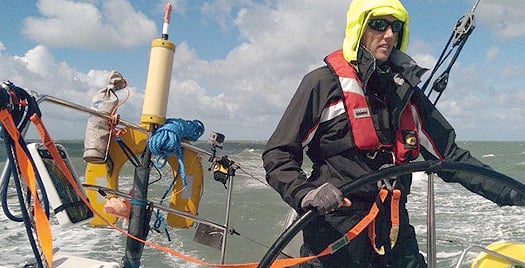
A great fair wind at last, but it was so very very cold despite some sunshine. Photo: Liam Coyne

Early morning as they pass St Kilda, with Lula Belle well placed in the race and her closest but higher-rated rivals astern. Photo: Iiam Coyne
By this stage the boat was very much their home, and they were both in good spirits. Despite the expectation of being in race mode for at least ten days and probably much more, they hadn't anything too much in the way of special easy-made instant food. When asked who had organized their stores and how they had been procured, Liam responded: "I just went to Tesco before the race, and filled her up. It's very easy when you've only two. I've had to do the stores for the boat with a crew of eight, and it's a pain in the neck".

Getting an omelette just right is tricky at the best of times, yet this masterpiece was created aboard Lula Belle off the coast of Donegal in 30 knots of wind. Photo: Liam Coyne
As for living aboard, they used the two aft cabins for sleeping, with hot bunking dictated by which was the weather side. In cruising mode, the First 36.7 is a very comfortable boat, but in racing things tend to get put behind the lee-cloth on the weather settee berth in the saloon, for the fact is the boat is designed to be raced with a crew of 7 or 8, and she tends to be a bit tender without six bodies on the weather rail.

Post-return temporary disorder in Lula Belle's saloon on her arrival back in Dun Laoghaire after sailing nearly 3000 miles in all since she'd last been in her home port. Though Brian (left) and Liam used the aft cabins for the short off-watch periods of sleep, the lee cloths on the settee berths were kept up to provide ready stowage for loose gear, preferably on the weather side. Photo: W M Nixon

Having the toilet on the fore-and-aft axis is very convenient at sea. And having an "extra-easy-cleaned" compartment is a real boon for hygienc. As for the funnel and hose, that's essential in a men-only boat in racing mode. Photo: W M Nixon
To my mind, one of the best things about the accommodation is the heads (toilet if you prefer). Some folk might think the compartment is too compact, but the loo is aligned fore and aft, so there simply isn't the room to fall about when using it. With the fore and aft alignment, security and comfort is guaranteed at those special private moments. It should be a law of yacht design that any boat which is going to be taken further than half a mile offshore is designed with a fore and aft loo.
Such thoughts would not have been forefront in the minds of Lula Belle's crew as they set the A3 spinnaker for the long run to Black Rock off the Mayo coast. Inexplicably, and as evidence of their stretched shoreside management support arrangements, they'd failed to bring along a new Code Zero spinnaker from sailmaker Des McWilliam. They'd gone for it despite it putting three extra notches on their rating, but it was nowhere to be found. After the race, it was discovered among a pile of 20 sails in Liam's Dublin office. But out in the lonely ocean southwest of St Kilda, it wasn't there when it was needed.
Yet it was soon needed even more. The smaller sail that was put up simply disintegrated after a brief period of use. It was inexplicable, but reasons weren't important just then, they were now down to just two spinnakers, and a very long way to go downwind to the finish.
So they nervously got out the A4, and soon it was up and drawing and Lula Belle was back in business, sailing fast for Ireland. Liam went below for a much-needed kip, and a sudden squall over-powered the boat. By the time he got back on deck she'd broached completely and the sail was shredded. They were down to just one spinnaker, and one in very dodgy condition at that. To add to their joys, in a crash gybe the mainsheet carriage disintegrated and they'd "ball bearings, it seemed like hundreds of them, all over the place...."
So there they'd been, passing St Kilda and knowing that, despite the lack of sailing instruments, they couldn't have done the leg from Shetland any better, and more importantly knowing from Yellowbrick that Rare was now well astern. Yet here they were now, only a few hours on the way, and they were down to one spinnaker and a jury-rigged mainsheet arrangement and a long way to go and the weather starting to suit Rare. Could it get any worse?
It did. Approaching the Blaskets, as usual the ship's batteries were draining with unreasonable speed. But the engine, when called upon, was dead. Dead as a dodo. It turned over but just wouldn't start. They knew that in very short order they'd be even further cut off from the outside world than they were already, with no chart plotter and without even the comfort of Yellowbrick to tell them how they stood in relation to the opposition. No autohelm whatever, either. And they'd 495 miles still to sail.
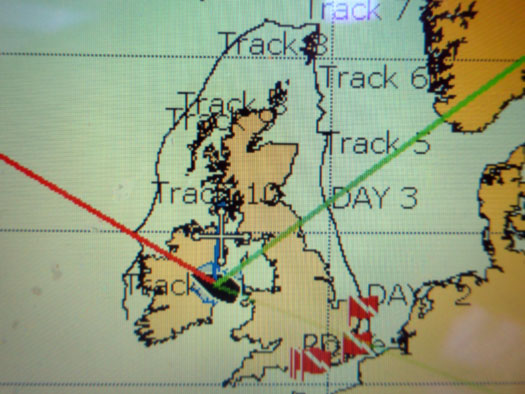
Moment of truth. The chart plotter's power dies just north of the Blaskets, the most westerly point of the 1802-mile course. Photo: W M Nixon

Getting on with it. Just south of the Blaskets, Brian goes aloft to try and clear the constantly-jamming Windex. Photo: W M Nixon
So they picked themeselves up, dusted themselves off, and started all over again. Brian went aloft to the waving masthead to free the Windex, which was in its jamming mood. Then progress was good heading down towards the Isle of Scilly. But even so, midway across, alone at the helm and steering and steering and steering, Liam admits to a very low moment.
They were now almost midway between Cowes and Dun Laoghaire, So he thought to himself: Why not just turn to port and head for home? Head for that comfortable NG34 berth in Dun Laoghaire marina, instead of struggling on with sails which were bound to shred even further, and leave them eventually straggling across the line completely dog last and with everything to fix, and then they'd have to turn round and plug into the early Autumn gales all the way back round Land's End to Dun Laoghaire?
And what then? he thought. Well, then in four years times we'll have to do the damned thing all over again. All, all, over again. So we'll just finish the bloody thing now, and get the T-Shirt, and that will be that regardless of how far we're placed behind everyone else, and good riddance to it all.
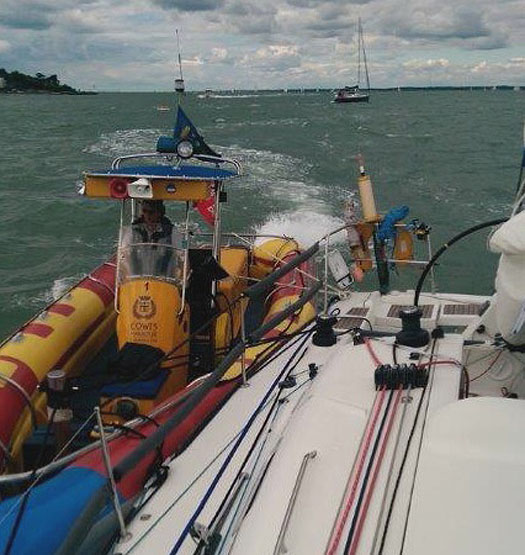
Welcome back. Knowing of Lula Belle's engine-less plight, the Cowes harbourmaster made sure they were brought into their Berth of Honour in style. Photo: Liam Coyne
So they stuck at it, they nursed the boat through the shipping separation zones at the Scillies without the spinnaker up because they knew the multiple gybing would destroy it, then as Rare didn't get past them until this stage, they knew that after such a long race she'd need to be 22 hours ahead at the finish and that was surely impossible. They were very much in with a shout of being better than last, so they nursed that mangled old spinnaker right up the English Channel (Mother Flahive's emergency sewing machine had done some marvellous repairs), and maybe the spreader ends were now showing out through the mainsail again, but what the hell, they got in round St Catherine's point and shaped their way back into the eastern Solent and on up to Cowes, and didn't Rare's crew and various bigwigs come out to tow them into port and confirm to them that they had indeed been there, they'd seen it, they'd done it, they'd won it., and now they could get the T-shirt.

Been there, seen it, done it, won it, got the T-shirt.....Liam Coyne back at the bar of the National YC five days after winning the two-handed division and two RORC classes in the 1802-mile Seven Stars Round Britain & Ireland Race 2014, and with his boat Lula Belle safely returned to her home port of Dun Laoghaire. Photo: W M Nixon
'It's Amazing How That Sail Held' - Skipper Talks Lula Belle At Round Britain & Ireland Finish
#RORCSRBI - Liam Coyne and his sailing partner Brian Flahive crossed the finish line at Cowes around lunchtime today on their plucky First 36.7 Lula Belle to claim sixth place overall in this year's Round Britain and Ireland Race. Writing from the relative comfort of the shore, Coyne shared with us the pair's final days of racing...
Day 11 started with a night approach to Scilies. We had a great run with the A5 kite down but the wind went forward and we arrived with the jib up.
The worst part of having only one kite left was when to use it. When we rounded the Scilly Islands we should have put kite up and done three or four jibes but we had a spreader stuck through the mail sail and A lot of dark night gybing with it and our last kite did not appeal.
We ended up sailing around the Scillies to Lands End with only the main sail up. It was torture watching Rare pass us and have to be so conservative but we wanted to finish.
At first sunrise we hoisted the A5 and kept it going for 24 hours to arrive at the Isle of Wight at 6am on day 13. Despite Brian sowing it three times and the flogging it got in the last 24 hours, it's amazing how that sail held.
We were lucky to arrive at St Catherine's Point with tide so had a nice easy finish.
I must say I was very appreciative of the crew of Rare, who we beat to second, to come back out to the finish line with their families on board to applaud us over the finish.
The harbour master were good enough to tow us the the marina where the RORC team met us with media and champagne. It was confirmed we won the IRC Two-Handed class and combined classes 3 and 4, and finished sixth overall.
We are overwhelmed with all the well-wishes and messages. It's amazing how many were following [the race]. Boats are now tied up and we have to start repairs. Still have a 450-mile trip home.
Certainly it's one of the toughest races ever but very doable, and I hope our success this year leads a lot of other smaller boats to do this challenge.
#RORCSRBI - As of 10am BST this morning, Liam Coyne's Lula Belle was bearing down on the finish line just 8.4 nautical miles from Cowes at the end of a remarkable Round Britain and Ireland Race.
The First 36.7, skippered by Coyne and crewed by Brian Flahive, already has first place in the IRC Four and Two-Handed categories in the bag – topping Ian Hoddle's already-home Figaro II Rare for the latter after time correction – and is set to be confirmed as the sixth place finisher overall.
That would be the icing on an incredible achievement for the Irish pair, who survived days of fatigue and potentially race-ending gear failure to strive to the end.
As reported yesterday on Afloat.ie, German entry Varuna – owned by Jens Kellinghusen – was declared the overall winner under IRC of this year's Sevenstar Round Britain and Ireland Race.
Varuna Declared Overall Winner Of Round Britain and Ireland Race
#RORCSRBI - The Royal Ocean Racing Club has declared Jens Kellinghusen's Ker 51 Varuna (GER) as the overall winner under IRC of the 2014 Sevenstar Round Britain and Ireland Race.
Race sponsors Sevenstar Yacht Transport have also awarded Jens Kellinghusen with a $20,000 voucher to ship Varuna to their selected destination worldwide, which will be used to transport the boat to Malta to take part in the Rolex Middle Sea Race, the final race of the RORC Season's Points Championship.
Although six yachts are still racing, none of them can better Varuna's corrected time racing under IRC.
Varuna has no powered winches and the tough conditions required tremendous physical exertion and long hours hiking out on the rail.
Kellinghusen was quick to praise his crew for their performance. "The weather conditions really suited Varuna," he said. "Our biggest competition was with the canting keel boats, which would have preferred reaching, but the downwind conditions towards the end were ideal for us.
"I am so happy for the crew as they all did a great job and the boat held together in some testing conditions. I am very pleased, this is the first time we have participated and we really enjoyed the race. We already use Sevenstar for transporting Varuna, so the $20,000 from the sponsors is very much appreciated."
Aside from team owner Kellinghusen, Varuna's winning crew comprised pit/boat captain Tim Daase from Wewelsfleth in Germany; runner Guenter Alajmo from Hamburg; navigator Guillermo Altadill from Barcelona; trimmers Luke Molloy from Brisbane, Australia and David Blass from Braunschweig, Germany; pit Fynn Terveer and drivers Jan Hilbert and Gunnar Knierim, all from Kiel in Germany; and bows Peter Knight from Guernsey, Christian Stoffers from Kiel and Alastair Sayers from Hobart, Tasmania.
At 9am BST this morning (Friday 22 August) the remaining six yachts racing in the Sevenstar Round Britain and Ireland Race were experiencing downwind conditions in plenty of breeze.
Relentless on Jellyfish, the J/122 skippered by James George, was just 38 miles from the finish holding off a strong challenge from the Army Sailing Association's J/111 British Soldier, which is six miles behind the on-the-water leader. Both yachts were expected to finish this afternoon.
Saga, the Hanse 531 skippered by Peter Hopps, passed The Lizard at midnight. At as of 9am this morning, Saga was 30 miles from Portland Bill with 100 miles to go. Saga is expected to finish the race around midnight on Saturday 23 August.
Just after midnight last night, Ian Hoddle's Figaro II Rare passed Liam Coyne's First 36.7 Lula Belle, as the two-handed teams approached the Scilly Isles. As of this morning Rare and crew had extended their lead by 11 miles to lead on the water as the two yachts passed The Lizard.
However, after time correction, Lula Belle is still the leading the two-handed class by a considerable margin. Werner Landwehr's Figaro II, Dessert D'Alcyone, was 70 miles from the Scilly Isles, 300 miles from the finish.
Coyne, skipper of Lula Belle, contacted the Royal Ocean Racing Club in the early hours of this morning. The Irish pair of Coyne and Brian Flahive have been racing for 11 days surviving gale-force winds, but fatigue and gear failure is taking its toll.
Lula Belle's engine has failed to start, essential to charge their batteries, and the sails are showing signs of the battering they have received.
Without access to the fleet tracking player on the RORC website, Coyne was unaware that Rare was passing them, going by what he wrote from Lula Belle while at sea, as previously reported on Afloat.ie.
Gear Failure No Set Back, Coyne & Flahive Still Lead Two Handed Round Britain & Ireland Race
#rorcsrbi – The Plucky National Yacht Club duo that have experienced major gear failure in the last 48 hours are still leading IRC Four and the Two-Handed Class of the Round Britain and Ireland Race with 360 miles to go. Liam Coyne, racing two-handed with Brian Flahive on First 36.7, Lula Belle, is making good speed across the Celtic Sea.
Werner Landwehr's Figaro II, Dessert D'Alcyone, was 35 miles from the Fastnet Rock at 0900 BST, having covered 140 miles in the last 24 hours. Ian Hoddle's Figaro II, Rare, have used their Code Zero to good effect covering 146 miles in the last 24 hours, more than any of the six other yachts still racing. Rare's Conrad Manning reports that the pink hull seems to be attracting a number of visitors as he explained by text message. "More dolphins and these ones have kids too!".
Six yachts are still racing in the Sevenstar Round Britain and Ireland Race and after light winds slowed their progress yesterday (Wednesday) morning, the wind picked up overnight much to the delight of the remaining competitors. British Soldier and Relentless on Jellyfish are having a tremendous battle in IRC Two and the three remaining Two-Handed teams are making great progress.
Wednesday afternoon JV 53, Bank von Bremen, skippered by Carol Smolawa and crewed by members of the SKWB (Segelkameradschaft das Wappen von Bremen), crossed the finish line of the Sevenstar Round Britain and Ireland Race completing the race in under 12 days to claim third position in IRC Zero.
"We had a bit of everything thrown at us in the race, the start was fantastic, downwind through the Solent and east out through the Straits of Dover but it was very tough up the North Sea and all the way around to St.Kilda on the west coast of Scotland," commented Carol Smolawa. "We had to tack against heavy winds and we were very happy when we passed the Shetlands and thought, good, we can now go downwind; but the low pressure just followed us all the time.
"I will remember the gale in the west and we had so many different situations to deal with and such high speeds. We had a daily distance of around 240 miles a day and that's incredible! The most special moment was when we had to set the storm jib. A safety warning was coming in from the Coastguard with Gale force 10 expected and we were prepared when the huge waves came crashing onto the boat. Our boat was strong and our crew made it.
"Finishing the race and coming back to Cowes is such a great feeling. We made it and it was such an amazing experience. It was the first time the SKWB Club and myself, plus all the young sailors on board, have done this race. Many years ago I saw the boats preparing for the Round Britain and Ireland Race and I thought 'I will do that one day'. It was so great and such an honour to do this race.
"We wrote to our Club saying that we have 11 sets of foulweather clothing and boots for sale at the end of this race! However, in a couple of days we will have changed our minds and you might see us in four years time. The RORC is such a great organisation and thank you all for such a great race, with great moments for us."
At 0900 BST Hanse 531, Saga, skippered by Peter Hopps, was 50 miles from the Scilly Isles having covered over 100 miles in the last 24 hours. Saga is expected to finish the race in the early hours of Saturday morning to claim first place in IRC One.
In IRC Two J/122, Relentless on Jellyfish, skippered by James George, had an excellent night. Gybing north of the rhumb line, Relentless on Jellyfish made a massive gain over the Army Sailing Association's J/111, British Soldier. At dawn this morning, Relentless on Jellyfish was the first yacht, still racing to pass the Scilly Isles. Over the last 24 hours, Relentless on Jellyfish has gained 26 miles on their rivals to lead the six yachts still racing.
"We can see British Soldier's kite behind us for the first time and we are now in 10 knots of wind planning on how to tackle the headlands along the south coast of England," commented James George. "We are determined to take line honours for the class, morale is good but it's tense on board, we know we have a real fight on our hands with British Soldier. It has been one hell of a race and we want to finish on a high, we are just trying sail fast and hang on to this lead."
British Soldier had to put an injured crewman ashore in the early part of the race. With just five on board, their watch system has had to change, resulting in far less rest and everybody on deck for every manoeuvre, regardless of watch:
"When we saw them (Relentless on Jellyfish) in front of us this morning it was a bit of a blow," commented Phil Caswell, British Soldier's skipper. "We were absolutely gutted but we are over that now and we have eyes on them, working as hard as possible to pass them. We know we have a quick boat downwind and we are determined."
#rorcsrbi – Dublin offshore two handers Liam Coyne and Brian Flahive are heading for the finish line of the Round Britain & Ireland Race on Saturday even though they have had a series of gear failures over the last 72 hours. Now – on day 10 – their engine, used to power batteries, will not start. Coyne sent this latest update to Afloat.ie this morning:
"When we thought there was nothing else left to fail the engine now will not start. This will probably be last mail from race. We are conserving all power to get us home. We are still not giving up and we have wind, a compass and charts so we can still finish. We now have 435 nm approx left and we feel we can safely cover that. We will inform you if there are any other developments"
Meanwhile, Swish, skippered by Canadian Roderick Knowles, crossed the finish line of the 2014 Sevenstar Round Britain and Ireland Race off the Royal Yacht Squadron, Cowes at 04.06.49 BST on Wednesday 20th August 2014 with an elapsed time of 8 days, 19 hours, 06 minutes and 49 seconds. Subject to ratification by the World Speed Sailing Record Council, this breaks the previous World Record for Monohulls 40 feet and less, set by Concise 2 in 2010, by over 18 hours.
This will be the fifth World Record broken during the 2014 Sevenstar Round Britain and Ireland Race organised by the Royal Ocean Racing Club.
Yesterday afternoon Custom JV52, Haspa Hamburg, finished the race to claim second in IRC Zero.
At 0900 BST on Day 10 JV53 Bank von Bremen, skippered by Carol Smolawa, is just 18 miles from the finish and is expected to be the 12th yacht to finish the Sevenstar Round Britain and Ireland Race and claim third place in IRC Zero. In IRC One Hanse 53, Saga, skippered by Peter Hopps, passed the Fastnet Rock in the early hours of Wednesday morning 390 miles from the finish.
In IRC Two there is a tremendous battle between J/122, Relentless on Jellyfish, skippered by James George, and J/111, British Soldier, skippered by Phil Caswell. Relentless on Jellyfish is sixteen miles behind the Army Sailing Association's British Soldier but leads on handicap by just 50 minutes.
The Irish Two-Handed team, Liam Coyne and Brian Flahive racing First 36.7, Lula Belle, spoke with the RORC Media Team as they approached the Irish Coast on Tuesday evening. "We are just off County Mayo, were I was born," said Liam Coyne. "All is well on board but we only have the A5 kite left, the other two are trashed and the mainsheet track has come away from the deck but it is nothing a bit of Irish engineering couldn't solve, I just hope it holds out. We are determined to finish this race but being so close to home makes us really want to get on with it."
The British Two-Handed team, Ian Hoddle and Conrad Manning racing Figaro II, Rare, have increased their lead over the German Figaro team, Dessert D'Alcyone, skippered by Werner Landwehr with crew Heiner Eilers. Rare is now 45 miles ahead, a gain of 25 miles over the last 24 hours.
#rorcsrbi – After nine days at sea and 500 miles still to sail, Liam Coyne and Brian Flahive are struggling to finish the 1800–mile Sevenstar Round Britain and Ireland Race this Saturday in Cowes. Two spinnakers gone, the mainsheet track shattered, Coyne asks 'what next?' from the deck of two-handed Irish First 36.7 Lulabelle, currently off the West Coast of Ireland.
We have been to far from shore over the last few days communications have not been possible.
Days 4 and 5 were just a hard slog against the tides and wind to get to the Shetlands but we finally got there. We rounded Muckle Flugga but knew there was a rough weather system coming from west. We had to decide to take shelter or head out. We decided to head west and we would be able to cross on southerly winds to the centre then head south on the north westerly winds the other side.
This would cost us a lot more time but it would be safer. Lula Belle 2 handed does not perform well up wind. With the lack of weight we get blown cross ways in the water.
We went west and it was a hard slog as our southerly winds were more south west and with wind it was very difficult to keep it west and not north.
Finally a day later and the winds died. We knew we were in the eye of it. On the way the Shetland Coastguard radio had moved from force 8 to force 9 and then warned as system had passed Faeroe Islands the winds were severe storm force 10. We were very apprehensive. We readied the boat with 3 reefs and storm sail and sat and waited. Two hours later for shift change Brian came up and asked for a report. I said it's like been stood up for a date. Your sitting here with all your gear and your date has not arrived. Two hours later when the storm hit Brian said, 'your date has arrived' and 'she's nasty'.
It was a nasty storm. I don't know if going west cost time but I was so glad we were meeting this from the north and not coming sideways to this storm. As we still have no wind instruments from day two we don't know how strong the winds were but the waves were enormous. There were massive waves from the north. These were not to bad as we could surf these. The small waves from the west were the dangerous ones. As they hit the stern of the boat they would cause her to turn to wind to round up. All we could do was to ride it out. Later the northerly waves got quite scary as they started to break behind us and water would fill the cockpit and on occasions in the wash boards. These were scary. They came in sets of 3 every 20 minutes.
Then to make things worse, waves from the east started. These were far more dangerous, as the west waves only caused round ups, these east ones caused us to accidentally gybe. And as anyone knows an accidental gybe is dangerous but in force 10 it's really not nice.
"An accidental gybe is dangerous but in a Force 10 it's really not nice..."
We had to turn the Boat more to weather and suffer the round ups as this was the safest option. We don't know the wind strength but we were doing 16–knots boat speed at one point with only a 3 reefed main and no head sail. We battled this for 12 hours. When it finally subsided. This was a night to remember but we were glad it was over.
We arrived at sunrise to the majestic sight of the Sun rising over St Kilda. The wind was about 20 and we had reached the half way point. We have no idea how we are doing in the race but now we have the A5 up and we are pushing for the home county of Mayo and Belmullet. With the speeds we are doing we should be there by Tuesday morning about 5am after 8 days. Sailing now with the kite was exciting but hard work. When your 2 hour shift finishes your arms feel like they are going to fall off your shoulders.
Then Monday night day 8 disaster strikes. Due to wind shifts we were back to white sails only and then the wind died. This was expected and really we needed to go to kites. But the night was so black we did not really chance flying the kites.
We have no wind instruments. And normally we would pick a cloud, star or something to point at but the sky is only black. No reference point. Very unstable ways to fly a kite. We took the decision at 2 am leave it so with main only we proceeded. By 4 am the sky had broked a little so we went for a hoist. Hoisted the brand new A2 for Brian to say there's a rip in that and there was. No sooner had he said those words than it completely shredded. Not one spin on the new kite.
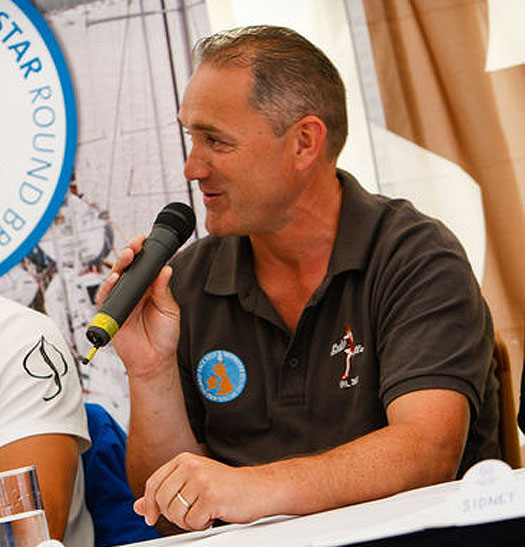
Liam Coyne at the pre–race press conference – Photo: Paul Wyeth/RORC
We then put up the A3 and went with that. I went to bed and Brian started his shift. 20 minutes later I was awoke been turned upside down as the Boat broached. It was not righting so I rushed up to help Brian. We finally stopped it flogging and the boat righted only for us to see this kite now also had come apart.
Completely deflated we got the kite back on board and decided to think about things. We were heading west so decided to gybe to Belmullet. Everything was going so good. We were screaming down south it looked like our racing now just started and our two weapons of kites are gone. What next?
Well as we gybed to Belmullet the track for the main sheet shattered. Bits of track everywhere. Bearings everywhere. Brian and I just looked at each other. We had come through everything that could have ruined our race and here on a mild night of no more than 16/18 knts of wind everything is going wrong.
So here we are on day 9. A lame duck. As always our main priority is safety of us and vessel and we believe nothing damaged or broken pose a threat to that. We have decided to try to finish. We have one small kite with a repair done to it left and our white sails.
It has to be said it's doubtful we will be able to finish but we will give it our best shot.
Liam and Brian, we're all behind you! – Ed.
Show your support for Lulabelle by leaving a message below:
Dublin Sailors Lead Round Britain & Ireland Race After Fantastic Run of 200 Miles in 24 Hours
#rorcsrbi – After more than a week at sea, Irish Two-Handed team, Liam Coyne and Brian Flahive racing First 36.7, Lula Belle, have had a fantastic 24 hour run, covering nearly 200 miles in the Round Britain and Ireland Race. Just 60 miles to go until Blackrock, the team will be welling up inside as they start to get a glimpse of the Irish coast during the day. Lula Belle is 620 miles (just under a full Round Ireland race distance) from the finish and their current estimated time of arrival in Cowes is midday on Saturday 23rd August. Lula Belle is currently leading the Two-Handed Class on the water and after time correction.
The British Two-Handed team, Ian Hoddle and Conrad Manning racing Figaro II, Rare, have covered 160 miles in the last 24 hours and have 700 miles to the finish. After Rare's pit-stop on the Isle of Lewis last night, the Two-Handed team have made a big gain. Werner Landwehr and Heiner Eilers racing two-up on their Figaro II, Dessert D'Alcyone, are just 19 miles behind Rare. This has created a fascinating battle at the back of the pack. Dessert D'Alcyone and Rare are both 32 feet in length and vying for the prize of the first 32 foot yacht to complete the race.
At 0800 this morning nine yachts were still racing. Ifan James, skipper of Stimpson 42 Palpatine, contacted the Royal Ocean Racing Club yesterday to retire from the race with all crew well. Palpatine left the Isle of Lewis in the early hours of Tuesday morning and is currently passing the Isle of Skye, east of the Outer Hebrides. A scenic sail past the stunning lochs of the West Coast of Scotland in good weather and dry clothes will be a dream compared to the rough conditions experienced over the last few days.
Roderick Knowles' Class40, Swish, rounded The Lizard just before dawn this morning. They are 150 miles from the finish and speeding along at over 8 knots, well inside world record pace for a yacht of 40ft or less. Swish is expected to finish the Sevenstar Round Britain and Ireland Race in the early hours of Wednesday morning (20th August).
Pride of Germany
Custom JV52, Haspa Hamburg skippered by Katrin Hilbert, is just 94 miles from the finish, 30 miles offshore south west of Portland Bill. The young crew are all members of the German yacht club, Hamburgischer Verein Seefahrt. Founded in 1903, the club's tradition is to encourage young people to take part in ocean racing. The vast majority of the crew is less than 25 years old. In 2010 the club's entry in the race, Norddeutsche Vermögen Hamburg, came 5th overall under IRC, taking just under 10 days to complete the course. For the 2014 race, Haspa Hamburg is currently 4th overall under IRC and should finish the race in under nine days.
BvB on board
Sent from on board Bank von Bremen to the race blog
Just 10 miles from the Scilly Isles with 237 miles to go, JV53 Bank von Bremen, skippered by Carol Smolawa, is crewed by members of the Segelkameradschaft das Wappen von Bremen (SKWB). Based in Bremen and founded in 1934, SKWB has about 700 members worldwide. It provides each member with the opportunity to use the club's own boats to race offshore and at national and international regattas.
Carol Smolawa sent in this message from the race course:
"After all the rough days, we have a wonderful sailing day and most important, we could dry our clothes! What a wonderful feeling to have dry boots and garments! Under gennaker we sail with 11 knots in sunny and warm conditions; who could not ask for more? Tomorrow morning we will see the Scilly Isles and then the final leg towards Cowes. We are all happy that we are competing in the Sevenstar Round Britain and Ireland Race. The boat and crew have no major incidences. Now we are giving it our best for the last leg to Cowes," writes Smolawa.
Jellyfish Goes West
J/122 Relentless on Jellyfish, skippered by James George, was positioned 30 miles off the west coast of Ireland last night, so far in the race only the Spanish Volvo Ocean 65, Team Campos, decided to go that far offshore. However, the move looks to be paying off. At St. Kilda, Relentless on Jellyfish was behind Hanse 53, Saga, skippered by Peter Hopps, and British Soldier, sailed by the Army Sailing Association. Relentless on Jellyfish seems to have benefited from more wind during the night and this morning has passed both Saga and British Soldier, moving into first position in IRC Two, just under two hours ahead of British Soldier.
Coyne & Flahive Reach Shetlands But Upwind Sailing Takes Its Toll
#rorcsrbi – Liam Coyne and Brian Flahive's progress continues in the 1800–mile Round Britain and Ireland race today. The Dublin two handed pair sent this update from Lulabelle as they approach the Shtland islands leaving them with a 1,000 mile to the Solent finish next week. "The first sign of things changing were the waves were now against us then the wind turned. The hard beat started to Shetland. Over 100 miles up wind. Wind in 20's again today.
Shackle on jib blew so we had to stop to fix that. While we were stopped we fixed nav lights. Bulb blew in lights but broke inside so we had to fit spare set to bow. Brian did same hanging from the pulpit. Despite my best efforts he did get dunked a couple of times so he can confirm the gauge saying water temperature 32c is also incorrect.
Life on board is still uncomfortable. The sailing is great it's all the other stuff that's a nuisance. Eating sleeping etc. All our injuries have come from falls down below as boat is rocked.
As day closes we see we have actually sailed 155 miles but only covered 110 of race course. The tide seems to be forever against us. And it's not so much the 2 knts you loose against it it's the 20 degrees you lose of pointing that kills you. The north sea tides are erratic and hard to work with.
Spirits are good anyway as we hope to see Shetlands tomorrow"



